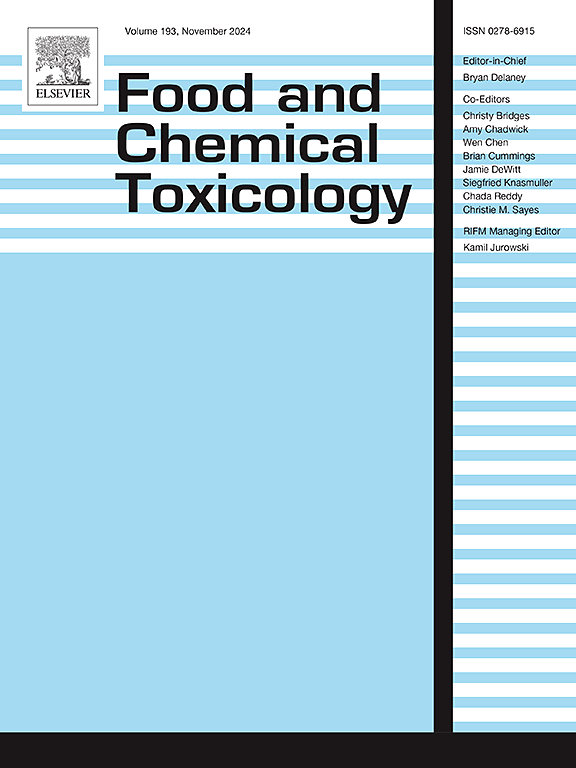Activation of Rab7-mediated lipophagy is required for triptolide to induce ferroptosis in hepatic cells
IF 3.9
3区 医学
Q2 FOOD SCIENCE & TECHNOLOGY
引用次数: 0
Abstract
The aim of this study was to investigate the regulation of triptolide on Rab7-mediated lipophagy to elucidate the potential association between lipophagy and ferroptosis in triptolide-induced hepatotoxicity. Human normal liver HL7702 cells and C57BL/6J mice were treated with triptolide to establish in vitro and in vivo models. The results revealed that triptolide caused a severe hepatic cell damage in vitro and in vivo. Concurrently, triptolide induced the remarkable activation of Rab7-mediated lipophagy, as evidenced by the decreased levels of lipid droplets and p62, the increased Rab7, microtubule-associated protein light chain 3Ⅱ (LC3Ⅱ) and phosphorylated adenosine monophosphate-activated protein kinase (AMPK) levels, as well as the increased colocalization of LC3 and Rab7 proteins. Moreover, triptolide obviously increased the levels of ferroptotic markers, including MDA, iron, prostaglandin endoperoxide synthase 2, and induced GSH and GPX4 exhaustion and oxidative stress in hepatic cells. Importantly, the inhibition of lipophagy mitigated ferroptosis and alleviated the hepatic cell damage induced by triptolide. our results demonstrated that triptolide-activated lipophagy with Rab7 serves as a pivotal factor in triggering ferroptosis and exacerbating hepatoxicity. The manipulation of lipophagy is thus a potential therapeutic strategy for ameliorating triptolide-induced hepatotoxicity.
雷公藤甲素诱导肝细胞铁下垂需要激活rab7介导的脂噬。
本研究的目的是研究雷公藤甲素对rab7介导的脂噬的调节,以阐明雷公藤甲素引起的肝毒性中脂噬与铁凋亡之间的潜在关联。采用雷公藤甲素处理人正常肝脏HL7702细胞和C57BL/6J小鼠,建立离体和体内模型。结果表明,雷公藤甲素在体内和体外均可引起严重的肝细胞损伤。同时,雷公雷甲素诱导Rab7介导的脂噬显著激活,表现为脂滴和p62水平降低,Rab7、微管相关蛋白轻链3Ⅱ(LC3Ⅱ)和磷酸化单磷酸腺苷活化蛋白激酶(AMPK)水平升高,LC3和Rab7蛋白共定位增加。雷公藤甲素显著提高肝细胞MDA、铁、前列腺素内过氧化物合成酶2水平,诱导肝细胞GSH、GPX4衰竭和氧化应激。重要的是,抑制脂噬可以减轻铁下垂,减轻雷公藤甲素引起的肝细胞损伤。我们的研究结果表明,雷公藤甲素激活的Rab7脂噬是引发铁凋亡和加剧肝毒性的关键因素。因此,操纵脂噬是一种潜在的治疗策略,以改善雷公藤甲素引起的肝毒性。
本文章由计算机程序翻译,如有差异,请以英文原文为准。
求助全文
约1分钟内获得全文
求助全文
来源期刊

Food and Chemical Toxicology
工程技术-毒理学
CiteScore
10.90
自引率
4.70%
发文量
651
审稿时长
31 days
期刊介绍:
Food and Chemical Toxicology (FCT), an internationally renowned journal, that publishes original research articles and reviews on toxic effects, in animals and humans, of natural or synthetic chemicals occurring in the human environment with particular emphasis on food, drugs, and chemicals, including agricultural and industrial safety, and consumer product safety. Areas such as safety evaluation of novel foods and ingredients, biotechnologically-derived products, and nanomaterials are included in the scope of the journal. FCT also encourages submission of papers on inter-relationships between nutrition and toxicology and on in vitro techniques, particularly those fostering the 3 Rs.
The principal aim of the journal is to publish high impact, scholarly work and to serve as a multidisciplinary forum for research in toxicology. Papers submitted will be judged on the basis of scientific originality and contribution to the field, quality and subject matter. Studies should address at least one of the following:
-Adverse physiological/biochemical, or pathological changes induced by specific defined substances
-New techniques for assessing potential toxicity, including molecular biology
-Mechanisms underlying toxic phenomena
-Toxicological examinations of specific chemicals or consumer products, both those showing adverse effects and those demonstrating safety, that meet current standards of scientific acceptability.
Authors must clearly and briefly identify what novel toxic effect (s) or toxic mechanism (s) of the chemical are being reported and what their significance is in the abstract. Furthermore, sufficient doses should be included in order to provide information on NOAEL/LOAEL values.
 求助内容:
求助内容: 应助结果提醒方式:
应助结果提醒方式:


